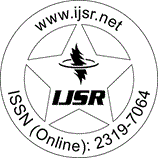Downloads: 5
India | Medicine | Volume 14 Issue 1, January 2025 | Pages: 330 - 331
Pleural Fluid Cytology as a Means of Diagnosing Malignant Pleural Effusions
Abstract: A terminal malignancy on the wrong side of the cycle of life is worst. It comes with it's set of constraints. . . constraints of co - morbidities, constraints of fitness for procedures, constraints of finances, constraints of caregivers, constraints of prognosis. At such times having a less invasive tool to zero in on the diagnosis helps a lot to ease the burden on the patient & his family. Presenting an observational study to assess the utility of pleural fluid cytology in patients reporting with signs & symptoms of suspected malignancy. Aim and objectives: To verify the usefulness of pleural fluid cytology as a mode of diagnosing malignant pleural effusions. To assess whether a less invasive procedure like pleural fluid sampling obtained via thoracocentesis can replace a more invasive percutaneous CT (computed tomography) guided or per - bronchoscopic lung biopsy in diagnosing malignancy in the non - affording or unwilling patients, or in those at risk of more invasive procedures due to age or infirmity. Methodology: This is an observational study of 21 elderly patients, aged between 60 to 75 years, presenting with gross, unilateral pleural effusions. Patients with CECT (contrast enhanced computed tomography) chest scans suggestive of gross pleural effusion and underlying lung mass were included in the study. CT guided & per - bronchoscopic biopsy samples were taken from the lung mass depending on the site of the lesion. Only histopathologically confirmed lung malignancy patients were included in the study. Diagnostic & therapeutic pleural tapping was done and samples were analysed. Light microscopy was used for pleural fluid examination. Co - relation between histopathology report positive for lung malignancy & pleural fluid cytology was studied. Results: It was observed that 10 out of 14 biopsy proven squamous cell carcinoma lung patients had pleural fluid cytology positive for malignancy (71.4%) while 3 out of 7 biopsy proven adenocarcinoma lung had positive pleural fluid cytology (42.9%). The positive yield from pleural fluid cytology for squamous cell carcinoma lung was found to be more than for adenocarcinoma lung. Conclusion: A common radiological presentation of advanced Ca lung is recurrently filling unilateral pleural effusion. Pleural fluid cytology is a quick and cost effective method to help diagnose malignant pleural effusion in suspected cases. A positive pleural fluid cytology helps in confirming a cancerous origin of an undiagnosed lung lesion in those patients unwilling or unfit for more invasive procedures like a lung biopsy or bronchoscopy.
Keywords: pleural fluid cytology, malignant pleural effusion, lung cancer diagnosis, less invasive procedures, squamous cell carcinoma
How to Cite?: Dr. Rutuja Prabhudesai, Dr. Ashish Deshmukh, Dr. Sunil Jadhav, Dr. Hafiz Deshmukh, Dr. Shivprasad Kasat, "Pleural Fluid Cytology as a Means of Diagnosing Malignant Pleural Effusions", Volume 14 Issue 1, January 2025, International Journal of Science and Research (IJSR), Pages: 330-331, https://www.ijsr.net/getabstract.php?paperid=SR25107123723, DOI: https://dx.doi.org/10.21275/SR25107123723
